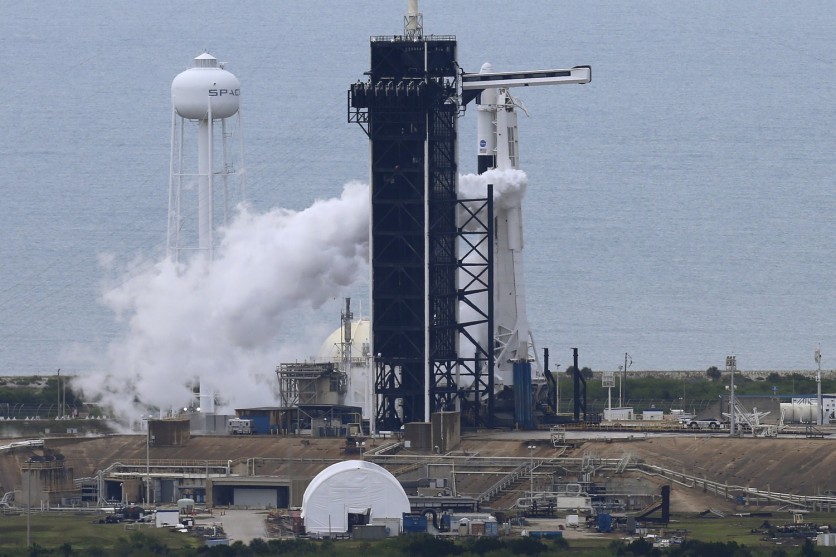SpaceX and NASA had to postpone their highly anticipated spaceflight as rain continuously poured around the launchpad.
At 4:17 p.m. on Wednesday, May 27, mission managers officially called off the launch because of the rough weather, about 40 minutes before lift-off. The SpaceX Crew Dragon would have launched from the Kennedy Space Center in Florida carrying NASA astronauts Robert Behnken and Douglas Hurley.

According to CNN, this flight is seen as historic as it would have been the first to take off from US soil with humans on-board since 2011. The earliest next window for the flight will be on Saturday at 3:22 p.m. ET.
SpaceX tweeted that the postponement was "due to unfavorable weather in the flight path."
Standing down from launch today due to unfavorable weather in the flight path. Our next launch opportunity is Saturday, May 30 at 3:22 p.m. EDT, or 19:22 UTC — SpaceX (@SpaceX) May 27, 2020
Also, in a video snap posted on Twitter, NASA Administrator Jim Bridenstine said "there was just too much electricity in the atmosphere," that could trigger lightning if the launch pushed through.
"It was a great day for NASA, it was a great day for @SpaceX. I think our teams worked together in a really impressive way, making good decisions all along." Administrator @JimBridenstine explains why the scrub today was the best decision to keep the #LaunchAmerica crew safe: pic.twitter.com/MVV85ZFx42 — NASA (@NASA) May 27, 2020
The event was attended by President Trump and Vice President Mike Pence who arrived separately at NASA's space center. Trump said on Twitter that he will come back on Saturday to witness the launch.
As of Wednesday morning, NASA officials already noted that there is only a 50% chance for today's launch as bad weather has affected Florida in the last few days. The forecast stated that primary concerns include "flight through precipitation, anvil could rule, and cumulus cloud rule."
This confirms US Air Force's 45th Weather Squadron launch weather officer Mike McAleenan's forecast during the Monday, May 25, briefing as a tropical storm builds up off the coast of South Carolina. McAleenan's team supervises all East Coast rocket launches and monitors the weather for NASA and SpaceX.
Although SpaceX's Crew Dragon capsule can break away from the rocket and fly the astronauts to safety in case any issues arise after the lift-off, SpaceX monitors weather conditions to prepare for any possible abort scenario.
Meanwhile, local authorities in Florida were expecting that spectators would gather on nearby beaches to watch the launch. NASA only allowed a few dozen journalists to cover the launch from the press area, but strict social distancing policies and guidelines were implemented. Bridenstine gave briefings over the phone while one-on-one interviews were conducted by each news agency.
What is the SpaceX and NASA launch aiming for?
Bridenstine hopes this launch will inspire the general public amid the health crisis. He also said the mission will keep the International Space Station manned with US astronauts. Also, this launch is a test for the space agency's future deals with the private sector.

SpaceX received a total of $3.14 billion in funding to develop and fly the Crew Dragon under NASA's Commercial Crew Program. This is also the first time that the space agency gave considerable freedom to the private sector to design, develop, and test a new human-rated spacecraft.
If SpaceX succeeds with this mission, it would be a huge win for NASA. Bridenstine is seeking private-sector partnerships to fulfill NASA's ambitious moon landing target in 2024.
Bridenstine told CNN Business' Rachel Crane that NASA is trying to have "numerous providers that are competing against each other on costs, innovation and safety" with this mission. "And then NASA can be a customer, one customer of many customers, and we already know that this will save a ton of money over the long term," Bridenstine added.
Read also: Apple's Recently Released macOS Catalina 10.15.5 Introduces New Battery Health and Facetime Features
ⓒ 2025 TECHTIMES.com All rights reserved. Do not reproduce without permission.




